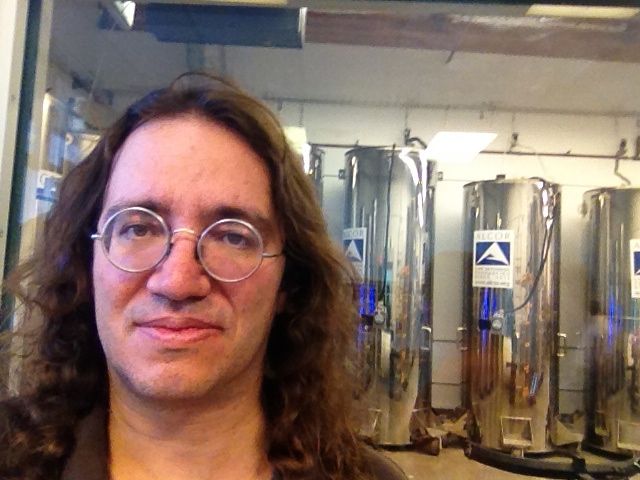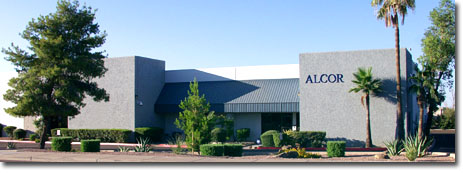Report from the Alcor-40 conference
October 24, 2012 by Ben Goertzel

The author at Alcor (credit: Ben Goertzel)
This past weekend I attended the Alcor 40 conference, hosted by the cryonics organization Alcor to celebrate its 40th year of operation, and I was extremely impressed.
(Full disclosure: I am an Alcor member, signed up in 2005 so that in the unfortunate event my body comes to meet the criteria of legal death, they will preserve it in liquid nitrogen until the advance of technology is sufficient to allow my reanimation in one form or another.)
The crowd consisted largely but not entirely of Alcor members; there was also a fair number of non-members interested in the technology and ideas. A bunch of folks signed up as members during the conference, as well.
Cryonics meets mainstream science
I was expecting some excellent talks on the current state of cryonics technology, from the particulars of preservation via vitrification with powerful cryoprotectants, to the pragmatics of transitioning a recently deceased body from the site of death to Alcor’s facilities. And the talks on these topics were indeed worthwhile, giving me faith that, in spite of quite limited funding for research and operations, Alcor is steadily improving all dimensions of their practice. Alcor’s new CEO Max More started in the position fairly recently, and from what I can tell he’s been doing a very professional job.
What surprised me was the depth of the talks on longevity science and neuroscience. One definitely got the feeling that cryonics is not nearly as marginalized as it was a decade ago or even five years ago, and is now accepted as a reasonable pursuit by a rapidly increasing subset of the scientific community.
Of course, this is part of a larger trend of the gradual mainstreaming of transhumanist technologies. AGI and nanotechnology, for example, were laughed at by most academics in relevant fields just 10–20 years ago. Now they are much more broadly acknowledged as valid and important pursuits, though there are still differences in vision between the maverick advocates and the interested folks in the academic mainstream.
Regarding longevity, along with some other interesting talks we saw a reprise of the debate between Aubrey de Grey and Michael Rose that occurred at the Humanity+ @ Caltech conference in 2010. Aubrey reported the latest results from his SENS project, including recent tests from a therapy that resolves some but not all of the neural damage associated with Alzheimers disease. Michael Rose presented a strong evolutionary argument for following a Paleo diet, especially for folks aged 40 or over, and presented results of recent experiments with flies on different diets to indirectly support his claim.
[More full disclosure: I consult for Genescient, the firm Michael Rose co-founded to study the genomics of long-lived flies he evolved in his lab. More on that here.]
While the two advocated different approaches, both talks were in the vein of “How to avoid the need to be cryo-preserved, or at least delay it as long as possible.”
Connectomics and cryonic versus chemical brain preservation
The session on brain preservation, with MIT neuroscientist Sebastian Seung and Janelia Labs neuroscientist Ken Hayworth, was perhaps the most interesting from my personal perspective.
Seung has recently written a trade book called Connectome, focused on the hypothesis that the human mind is contained in the neural connectivity structure of the human brain. As he put it:
“Hypothesis: You are your connectome. Your connectome is unique and contains a huge amount of information. That information includes your memories, personality and other aspects of your personal identity.”
Connectome devotes a chapter to cryonics. As he pointed out in his talk, this chapter brought him protests from both the cryonics community and some of his scientific colleagues. Some of his colleagues wondered why he was speaking relatively positively of such wacky stuff. But some cryonicists, such as Ralph Merkle, took exception to the way Seung associated cryonics with religions feelings and inclinations.
Seung also touted eyewire.org … a “citizen science” website, focused on mobilizing volunteers to interact with AI to help map the retinal connectome.
Hayworth discussed the possibilities of brain preservation via chemopreservation, such as plastination, an alternative to cryopreservation such as Alcor currently practices. He also presented the Brain Preservation Prize, a prize to be offered to the first team to prove successful preservation of a human brain’s connectome according to specified criteria. The Brain Preservation Prize is agnostic regarding technique — Hayworth’s own work focuses on chemical preservation, but the prize itself may be awarded to a team doing chemical, cryonic or any other kind of preservation.
While both researchers expressed confidence that the human self and memory are most likely implicit in the brain’s connectome, neither was willing to wholly rule out that other aspects of brain structure might be important, e.g., details of the molecules in the brain beyond mere neural connectivity. As Seung noted, “It’s not enough to say that what you do is based on the best knowledge that neuroscience has to say. Neuroscientists don’t know how the brain works….” Their consensus seemed to be that, even if ultimately other aspects of the brain prove important too, the connectome — with its trillions of inter-neural connections, adding up to millions of miles in total — is definitely the place to start.
The panel discussion following their talks featured intriguing back-and-forth regarding the benefits and problems associated with both cryonic and chemical preservation of human brains.
An obvious, major difference between the two approaches to brain preservation is: If cryoporeservation is done sufficiently well, it may be plausible to re-animate the cryopreserved person simply by defrosting them in a sufficiently gentle way, and infusing them with appropriate chemicals. On the other hand, if a brain is plastinated, for example (a common method of chemical preservation), then there’s no way to revive that brain without advanced nanotechnology. Instead one has to count on reading out the preserved brain’s connectome; and then re-creating the connectome and hence, presumably, the associated mind in some other substrate.
But it’s not clear that, even given recent advances in cryopreservation technology, it can match the precision with which chemical preservation techniques preserve the connectome and other aspects of brain structure. This is a tricky but important research issue, since cryonic technology is rapidly developing, and since the technology for reading brain structure out of cryopreserved brains is not all that mature (the standard method now involves chemically preserving the cryopreserved brain and then studying it).
The Brain Preservation Prize seems like a great idea, and hopefully will be first in the line of a series of prizes aimed at pushing brain and body preservation technology forwards.
Touring Alcor’s Facilities
The conference talks spanned Saturday morning and afternoon and Sunday morning. Sunday afternoon was devoted to a barbecue and a tour of Alcor’s facilities. The barbecue was tasty but the tour was more interesting. The facilities were modern, clean and well-organized, giving the feeling of a top-notch medical establishment. A 3D printer was in evidence, being used to manufacture various doohickeys needed to maintain and enhance the lab equipment, as well as to create small plastic souvenir models of the “Dewar” chambers in which Alcor’s patients are maintained.
Seeing the equipment used to perfuse recently deceased bodies and brains with cryoprotectant chemicals was interesting. But the high point was, of course, the room full of Dewars containing cryonically preserved bodies, waiting for technology to mature sufficiently to enable their reanimation. A thick, bulletproof glass window allows visibility into the Dewar room from the main Alcor conference room — a set-up that doubtless provides Alcor staff with a vivid reminder of what their work is all about, as they carry out their meetings.
My tour through the Alcor facilities was very ably conducted by Alcor CEO Max More. Longevity guru Aubrey de Grey, also taking part in the tour, provided helpful commentary along the way, displaying his own sound knowledge of cryonics procedures and technology.
All in all, it was an interesting and educational weekend. Alcor’s professionalism gives me reasonable faith that, in the unfortunate event I need to make use of their services, my preserved body will be well taken care of.
And now I’ll get back to my usual pursuits — such as working on AGI and on the genomics of longevity — which I hope will obviate the need for me ever to take up residence in one of Alcor’s shiny silver Dewars.
As I always say when discussing cryonics, “Better frozen than rotten…. But, better living than frozen.”
Reprinted with permission from H+ Magazine
